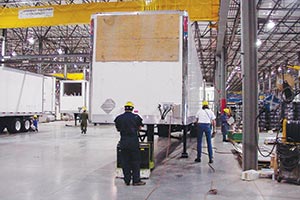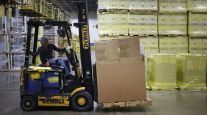Senior Reporter
Trailer Orders Top 21,000

This story appears in the Nov. 28 print edition of Transport Topics
U.S. trailer orders climbed above 21,000 in October for the second-highest total of the year, as analysts said the cycle is stabilizing after the tremendous surge in orders during the previous two years.
The preliminary net total was 21,050, according to ACT Research Co., adding that it would have a final tally later in the month. A researcher for the firm said any revision would be within 3% of the initial figure.
Orders fell about 37% compared with 33,279 in October 2015, ACT said, and were off by a similar percentage in the year-to-date period.
“I have heard of at least one big deal that is under negotiation, but even if that comes to pass, it is a deal at an [original equipment manufacturer]. It is not a widespread kind of order placement that we saw a year ago,” said Frank Maly, ACT’s director of commercial vehicle transportation analysis and research.
Orders were almost 316,000 for all of 2015, ACT said. In 2014, they were 359,000.
For the first 10 months of this year, net new trailer orders were about 158,030 units.
“Orders continue to kind of stumble along,” Maly said. “Large fleets remain cautious. Dealers do as well, since they serve the small- to medium-size fleets, many of whom have been on the sidelines for quite a while.”
But trailer makers sounded relieved.
“The soft summer pattern is over,” said Larry Roland, director of marketing at Utility Trailer Manufacturing Co. “We saw a prolonged pause through September and have now seen the welcomed weekly increases in October, which was about even for reefers and dry vans for us.”
The improving order intake is a sign customers see freight recovering or anticipate it recovering soon, Roland added.
Research company FTR pegged final net orders at 20,200.
“Despite a decline from 2015, this year still looks like a decent year,” said Don Ake, FTR’s vice president of commercial vehicles.
FTR noted trailer orders have totaled 213,000 units in the 12 months ended Oct. 31.
October orders were “remarkably normal,” Stifel, Nicolaus & Co. analyst Michael Baudendistel said.
ACT’s preliminary net total, he wrote in a note to investors, “was almost exactly in line with the 20-year-average October order level.”
Asked for his sense of demand in October, Glenn Harney, chief sales officer at Hyundai Translead, said, “I think it’s still fairly normal.”
At Great Dane Trailers, volume in October reflected a mix of replacement and growth-based orders for refrigerated vans, dry vans and, to a lesser extent, flatbeds, said David Gilliland, vice president of national accounts.
“We do expect that in the next 30 days there will be a push for those who haven’t ordered, to get their orders in and slots reserved,” he said. “The demand for 2017 is there.”
At Strick Group, “Since the presidential election, pending orders have broken loose into signed orders at a dramatic pace, and OEM backlogs are growing daily,” Chief Sales Officer Charles Willmott said.
“Customers who have taken a wait-and-see position on their 2017 capital acquisitions are well-advised to re-evaluate sooner rather than later,” he added. “It is an interesting time.”
“There’s still a pent-up demand for replacing extremely aged equipment going back to the 1998-2000 timeframe … and that equipment would have been replaced during the last downturn or shortly thereafter, and there is still some catch-up going on, trying to get that equipment out,” Brent Yeagy, president of Wabash National Corp., said during an earnings conference call Oct. 25.
Meanwhile, at Utility, backlogs reach well into the second quarter for refrigerated trailers and well into the first quarter for dry vans, Roland said.
FTR’s Ake said the industry had gotten used to backlogs being huge in 2014 and 2015.
It is now at about 90,000 units overall, a more typical level, Ake said. “We’re back to 2013, which was not a bad year.”
Going into the build year of 2014, the backlog was only 87,000 units, he said.
Backlog “will maybe be a little better by December,” Ake said.
Stifel’s Baudendistel said current orders and moderating backlogs support his 2017 production estimate of 235,000 units, down 20% year-over-year.
“Average production over the last 20 years has been roughly 218,000 units,” he wrote. “Our 2018 estimate of 225,000 units remains more considerably below ACT Research’s estimate of roughly 245,000 units.”
Meanwhile, order cancellations were not much of a factor in October because most soft orders have been “flushed through the system by this point,” Maly said.


